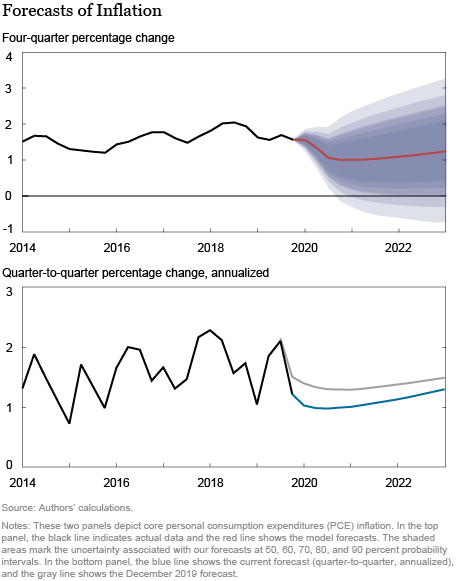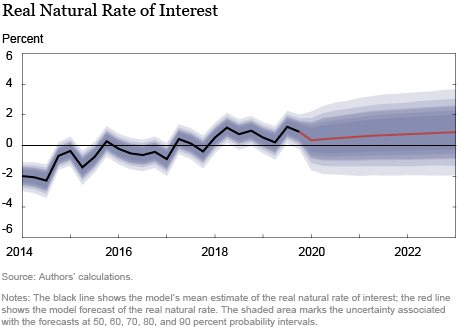Editor’s note: The release of the March 2020 DSGE forecast was postponed as New York Fed economists shifted their focus to the COVID-19 pandemic. With the June 2020 forecast now out, we’ve decided to post this forecast for the record as well.
This post presents an update of the economic forecasts generated by the Federal Reserve Bank of New York’s dynamic stochastic general equilibrium (DSGE) model. We describe very briefly our forecast and its change since December 2019. As usual, we wish to remind our readers that the DSGE model forecast is not an official New York Fed forecast, but only an input to the Research staff’s overall forecasting process. For more information about the model and variables discussed here, see our DSGE model Q & A.
The March model forecast for 2020-23 is summarized in the table below, alongside the December forecast, and in the following charts. The model uses quarterly macroeconomic data released through the fourth quarter of 2019, and financial data available through March 10, 2020. In particular, the model takes on board the 50 basis point cut in the federal funds rate that occurred on March 3.
How do the latest forecasts compare with the December forecasts?
- The current 2020 Q4/Q4 GDP growth forecast is substantially weaker than the one from December (0.8 percent versus 1.7 percent). This projection mostly reflects the worsening of financial conditions in the current quarter, in spite of the recent policy easing. GDP growth is projected to rebound to 1.8 percent in 2021 and increase a bit further to 2.1 percent by the end of the forecast horizon, as the adverse effect of tighter financial conditions on economic activity abates.
- Core PCE inflation is expected to be lower than forecasted in December, because the deterioration of financial conditions acts as a demand shock in the model, exerting downward pressure on both output and economic activity.
- The estimates of the real natural rate of interest in 2020 are much lower than in December (0.5 percent versus 0.9 percent), and they remain lower throughout the forecast horizon.




Ozge Akinci is an economist in the Federal Reserve Bank of New York’s Research and Statistics Group.

William Chen is a senior research analyst in the Bank’s Research and Statistics Group.

Marco Del Negro is a vice president in the Bank’s Research and Statistics Group.

Ethan Matlin is a senior research analyst in the Bank’s Research and Statistics Group.

Reca Sarfati is a senior research analyst in the Bank’s Research and Statistics Group.
How to cite this post:
Ozge Akinci, William Chen, Marco Del Negro, Ethan Matlin, and Reca Sarfati, “The New York Fed DSGE Model Forecast—March 2020,” Federal Reserve Bank of New York Liberty Street Economics, June 19, 2020, https://libertystreeteconomics.newyorkfed.org/2020/06/the-new-york-fed-dsge-model-forecastmarch-2020.html.
Disclaimer
The views expressed in this post are those of the authors and do not necessarily reflect the position of the Federal Reserve Bank of New York or the Federal Reserve System. Any errors or omissions are the responsibility of the authors.










 RSS Feed
RSS Feed Follow Liberty Street Economics
Follow Liberty Street Economics